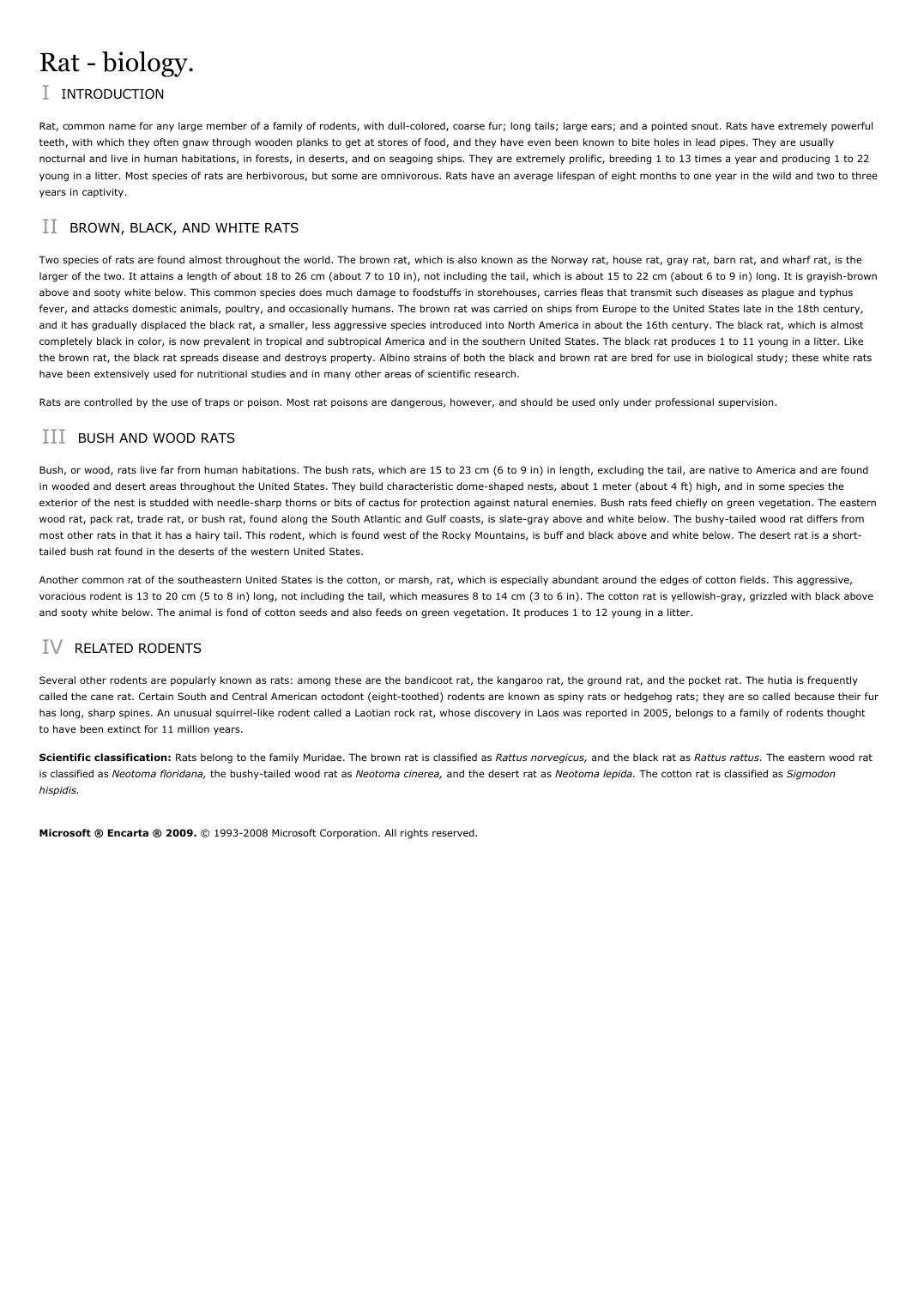Rat - biology.
Publié le 06/12/2021

Extrait du document
Ci-dessous un extrait traitant le sujet : Rat - biology.. Ce document contient 796 mots. Pour le télécharger en entier, envoyez-nous un de vos documents grâce à notre système d’échange gratuit de ressources numériques ou achetez-le pour la modique somme d’un euro symbolique. Cette aide totalement rédigée en format pdf sera utile aux lycéens ou étudiants ayant un devoir à réaliser ou une leçon à approfondir en : Echange
Rat - biology.
I
INTRODUCTION
Rat, common name for any large member of a family of rodents, with dull-colored, coarse fur; long tails; large ears; and a pointed snout. Rats have extremely powerful
teeth, with which they often gnaw through wooden planks to get at stores of food, and they have even been known to bite holes in lead pipes. They are usually
nocturnal and live in human habitations, in forests, in deserts, and on seagoing ships. They are extremely prolific, breeding 1 to 13 times a year and producing 1 to 22
young in a litter. Most species of rats are herbivorous, but some are omnivorous. Rats have an average lifespan of eight months to one year in the wild and two to three
years in captivity.
II
BROWN, BLACK, AND WHITE RATS
Two species of rats are found almost throughout the world. The brown rat, which is also known as the Norway rat, house rat, gray rat, barn rat, and wharf rat, is the
larger of the two. It attains a length of about 18 to 26 cm (about 7 to 10 in), not including the tail, which is about 15 to 22 cm (about 6 to 9 in) long. It is grayish-brown
above and sooty white below. This common species does much damage to foodstuffs in storehouses, carries fleas that transmit such diseases as plague and typhus
fever, and attacks domestic animals, poultry, and occasionally humans. The brown rat was carried on ships from Europe to the United States late in the 18th century,
and it has gradually displaced the black rat, a smaller, less aggressive species introduced into North America in about the 16th century. The black rat, which is almost
completely black in color, is now prevalent in tropical and subtropical America and in the southern United States. The black rat produces 1 to 11 young in a litter. Like
the brown rat, the black rat spreads disease and destroys property. Albino strains of both the black and brown rat are bred for use in biological study; these white rats
have been extensively used for nutritional studies and in many other areas of scientific research.
Rats are controlled by the use of traps or poison. Most rat poisons are dangerous, however, and should be used only under professional supervision.
III
BUSH AND WOOD RATS
Bush, or wood, rats live far from human habitations. The bush rats, which are 15 to 23 cm (6 to 9 in) in length, excluding the tail, are native to America and are found
in wooded and desert areas throughout the United States. They build characteristic dome-shaped nests, about 1 meter (about 4 ft) high, and in some species the
exterior of the nest is studded with needle-sharp thorns or bits of cactus for protection against natural enemies. Bush rats feed chiefly on green vegetation. The eastern
wood rat, pack rat, trade rat, or bush rat, found along the South Atlantic and Gulf coasts, is slate-gray above and white below. The bushy-tailed wood rat differs from
most other rats in that it has a hairy tail. This rodent, which is found west of the Rocky Mountains, is buff and black above and white below. The desert rat is a shorttailed bush rat found in the deserts of the western United States.
Another common rat of the southeastern United States is the cotton, or marsh, rat, which is especially abundant around the edges of cotton fields. This aggressive,
voracious rodent is 13 to 20 cm (5 to 8 in) long, not including the tail, which measures 8 to 14 cm (3 to 6 in). The cotton rat is yellowish-gray, grizzled with black above
and sooty white below. The animal is fond of cotton seeds and also feeds on green vegetation. It produces 1 to 12 young in a litter.
IV
RELATED RODENTS
Several other rodents are popularly known as rats: among these are the bandicoot rat, the kangaroo rat, the ground rat, and the pocket rat. The hutia is frequently
called the cane rat. Certain South and Central American octodont (eight-toothed) rodents are known as spiny rats or hedgehog rats; they are so called because their fur
has long, sharp spines. An unusual squirrel-like rodent called a Laotian rock rat, whose discovery in Laos was reported in 2005, belongs to a family of rodents thought
to have been extinct for 11 million years.
Scientific classification: Rats belong to the family Muridae. The brown rat is classified as Rattus norvegicus, and the black rat as Rattus rattus. The eastern wood rat
is classified as Neotoma floridana, the bushy-tailed wood rat as Neotoma cinerea, and the desert rat as Neotoma lepida. The cotton rat is classified as Sigmodon
hispidis.
Microsoft ® Encarta ® 2009. © 1993-2008 Microsoft Corporation. All rights reserved.
Rat - biology.
I
INTRODUCTION
Rat, common name for any large member of a family of rodents, with dull-colored, coarse fur; long tails; large ears; and a pointed snout. Rats have extremely powerful
teeth, with which they often gnaw through wooden planks to get at stores of food, and they have even been known to bite holes in lead pipes. They are usually
nocturnal and live in human habitations, in forests, in deserts, and on seagoing ships. They are extremely prolific, breeding 1 to 13 times a year and producing 1 to 22
young in a litter. Most species of rats are herbivorous, but some are omnivorous. Rats have an average lifespan of eight months to one year in the wild and two to three
years in captivity.
II
BROWN, BLACK, AND WHITE RATS
Two species of rats are found almost throughout the world. The brown rat, which is also known as the Norway rat, house rat, gray rat, barn rat, and wharf rat, is the
larger of the two. It attains a length of about 18 to 26 cm (about 7 to 10 in), not including the tail, which is about 15 to 22 cm (about 6 to 9 in) long. It is grayish-brown
above and sooty white below. This common species does much damage to foodstuffs in storehouses, carries fleas that transmit such diseases as plague and typhus
fever, and attacks domestic animals, poultry, and occasionally humans. The brown rat was carried on ships from Europe to the United States late in the 18th century,
and it has gradually displaced the black rat, a smaller, less aggressive species introduced into North America in about the 16th century. The black rat, which is almost
completely black in color, is now prevalent in tropical and subtropical America and in the southern United States. The black rat produces 1 to 11 young in a litter. Like
the brown rat, the black rat spreads disease and destroys property. Albino strains of both the black and brown rat are bred for use in biological study; these white rats
have been extensively used for nutritional studies and in many other areas of scientific research.
Rats are controlled by the use of traps or poison. Most rat poisons are dangerous, however, and should be used only under professional supervision.
III
BUSH AND WOOD RATS
Bush, or wood, rats live far from human habitations. The bush rats, which are 15 to 23 cm (6 to 9 in) in length, excluding the tail, are native to America and are found
in wooded and desert areas throughout the United States. They build characteristic dome-shaped nests, about 1 meter (about 4 ft) high, and in some species the
exterior of the nest is studded with needle-sharp thorns or bits of cactus for protection against natural enemies. Bush rats feed chiefly on green vegetation. The eastern
wood rat, pack rat, trade rat, or bush rat, found along the South Atlantic and Gulf coasts, is slate-gray above and white below. The bushy-tailed wood rat differs from
most other rats in that it has a hairy tail. This rodent, which is found west of the Rocky Mountains, is buff and black above and white below. The desert rat is a shorttailed bush rat found in the deserts of the western United States.
Another common rat of the southeastern United States is the cotton, or marsh, rat, which is especially abundant around the edges of cotton fields. This aggressive,
voracious rodent is 13 to 20 cm (5 to 8 in) long, not including the tail, which measures 8 to 14 cm (3 to 6 in). The cotton rat is yellowish-gray, grizzled with black above
and sooty white below. The animal is fond of cotton seeds and also feeds on green vegetation. It produces 1 to 12 young in a litter.
IV
RELATED RODENTS
Several other rodents are popularly known as rats: among these are the bandicoot rat, the kangaroo rat, the ground rat, and the pocket rat. The hutia is frequently
called the cane rat. Certain South and Central American octodont (eight-toothed) rodents are known as spiny rats or hedgehog rats; they are so called because their fur
has long, sharp spines. An unusual squirrel-like rodent called a Laotian rock rat, whose discovery in Laos was reported in 2005, belongs to a family of rodents thought
to have been extinct for 11 million years.
Scientific classification: Rats belong to the family Muridae. The brown rat is classified as Rattus norvegicus, and the black rat as Rattus rattus. The eastern wood rat
is classified as Neotoma floridana, the bushy-tailed wood rat as Neotoma cinerea, and the desert rat as Neotoma lepida. The cotton rat is classified as Sigmodon
hispidis.
Microsoft ® Encarta ® 2009. © 1993-2008 Microsoft Corporation. All rights reserved.
↓↓↓ APERÇU DU DOCUMENT ↓↓↓
Liens utiles
- La fin du rat
- « C'est propre la tragédie. (...) Et puis surtout c'est reposant la tragédie, parce qu'on sait qu'il n'y a plus d'espoir, le sale espoir ; qu'on est pris, qu'on est pris comme un rat, avec tout le ciel sur notre dos, et qu'on n'a plus qu'à crier, pas à gémir, non, pas à se plaindre, - à gueuler à pleine voix ce qu'on avait à dire, qu'on avait jamais dit et qu'on ne savait peut-être même pas encore ». Dans quelles mesures cette définition de la tragédie correspond-elle à Phèdre de Racin
- Cod - biology.
- Ray - biology.
- Cat - biology.


